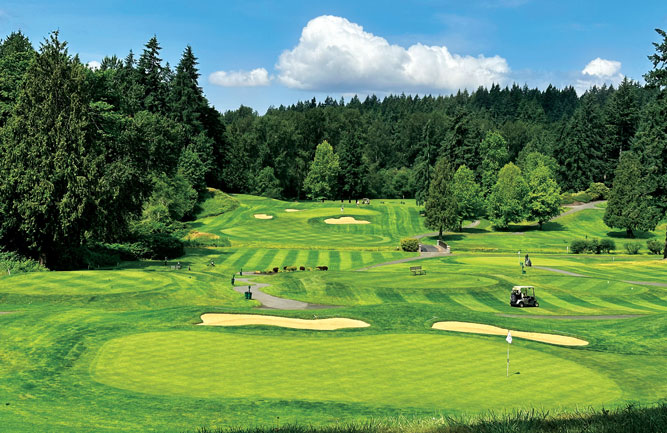2018 State of the Industry: Focused on the future while learning from the past
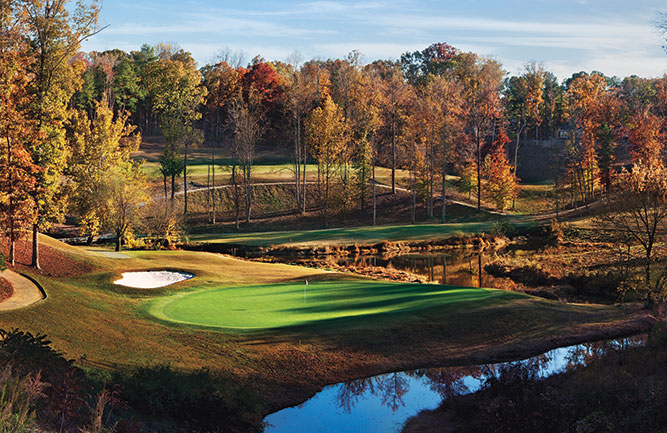
Cider Ridge Golf Club Superintendent Michael Mays says that rounds at his club are up by a few hundred over last year. (Photo: Cider Ridge Golf Club)
Suddenly, 2018 is in the rearview mirror. Where did the time go?
For our 2018 State of the Industry report, sponsored by Nufarm, we embarked on a journey to learn what the golf season was like across the country. From New York and Florida all the way to the West Coast and even Hawaii, we talked to GCSAA chapter presidents and representatives to learn about regional weather, disease pressures, challenges and successes. This report, spanning 15 different states, covers a lot of ground. From brown patch and Pythium to raging wildfires, superintendents saw it all this year.
While some problems are practically universal (labor, water), other problems drastically change from state to state, or even county to county. Golf courses a mere 30 miles apart experience different rain totals, different disease pressures, different temperatures. Providing the best conditions possible is the goal from course to course, but how each course gets there is totally unique.
However, there are some things on which every superintendent can agree. Like what Paul Derry, president of the Northwest Ohio Golf Course Superintendents Association, and superintendent of Catawba Island Club in Port Clinton, Ohio, told us: “If you didn’t lose a lot of turf and you kept your job, it was a successful year.”
Andy Cordova
President, Central California Golf Course Superintendents AssociationSuperintendent, Cypress Ridge Golf Course, Arroyo Grande, Calif.
Generally speaking, how was the golf season this year?
I feel as though we’ve had a season that has been the same as it’s been for the past two or three years. We haven’t seen a huge increase in play, but we haven’t really seen a decline either. I guess if it’s tipping the scale one way or another, we are on the upswing regarding the amount of play.
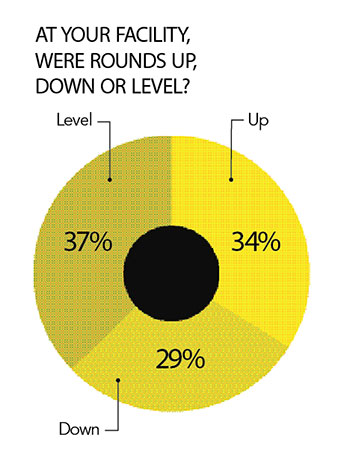
Figure 1 (Graph: Golfdom Staff)
How did the weather treat you this season?
Weather was very mild throughout the year, with a lower-than-average rainfall for the winter. On the Central Coast (where we are located), there are a lot of micro-climates. We can see a 10-degree difference within 10 to 15 miles and a quarter-inch of rain difference within that distance, too. I feel as though we were actually a little cooler than we normally are throughout the summer and a little warmer through the winter. Right now, we’re pretty much on par, though.
How would you describe the disease pressure this year, and what diseases were most prevalent?
The disease pressure was pretty much nonexistent until about a month ago, when we had one of the biggest outbreaks of dollar spot that I have seen since I started here 16 years ago. We sprayed it twice to completely remove it — usually we only spray once and it’s gone. The severity of it definitely took us by surprise, so we really had no extra cultural practices in place to help us.
What was the biggest challenge your area had to deal with this year?
The biggest challenge we’ve had to deal with is — as has been the case the past few years — the water situation. The first year of the major water restrictions was definitely a big challenge, but the past couple of years have been a little easier for two reasons. First, we are getting used to it and have learned how to work with the restrictions. In addition, the more wet winters have definitely lessened the pressure.
— Interviewed by Chris Lewis
Andy Jorgensen
President, Seven Rivers Golf Course Superintendents Association
CGCS, On Top of the World Communities, Inc., Ocala, Fla.
Generally speaking, how was the golf season this year?
We’ve been having an excellent year for golf. It seems the uptick in the economy is finally starting to trickle back down, as people are spending their discretionary funds again.
We had a better-than-expected spring, as rounds were slightly up heading into summer. Since we are a developer, construction has been booming and we have a lot of new residents moving in who have joined the clubs. These new residents are different from what we saw more than 10 years ago. More discretionary income — along with the need for socialization — has allowed us to keep the courses full.
Additionally, our “Get Golf Ready” programs (for new golfers) are starting to pay off, and we continue to see women picking up clubs for the first time. We added forward tees on a course a few years ago, and these have gained popularity among beginners and aging golfers. We’re looking into adding these to another course next year as well, to lead more people to play golf.
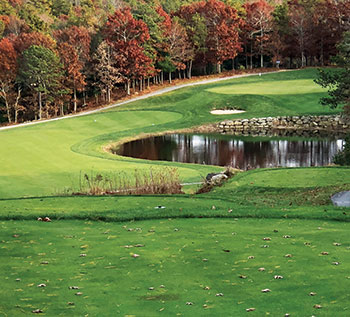
Crosswinds Golf Club’s Brian Smoot says that Cape Cod experienced a very hot summer and a lot of Pythium pressure this year. (Photo: Brian Smoot)
How did the weather treat you this season?
So far, so good — no hurricanes or major storms! We had significant rain in June and July, but it started tapering off a bit earlier than normal.
How would you describe the disease pressure this year, and what diseases were most prevalent?
We didn’t have any pressure that was out of the ordinary. It is critical to stay on top of preventative applications though. After 13 years of being at the same course, you tend to know what to expect and when. We continue to monitor and adjust our preventative applications for maximum success.
What was the biggest challenge your area had to deal with this year?
Labor continues to be a huge challenge. Even with an increase in starting pay for our staff, we continue to see very few new applicants coming through the door. We’ve had to rethink our hiring strategies and work better to retain the employees we have. We’ve also been trying to reduce as much detail work as possible. We’re using non-selective herbicides in areas that otherwise would need manual trimming, increased our use of growth regulators and purchased larger mowers to cover more ground. We’ve also improved our employee appreciation program to make this a more desirable workplace.
By adding such things as ice cream trucks at the end of the day, along with employee cookouts and giveaways, our crews remain motivated. We also highlight our benefit program and discuss this with the staff. Often, they only look at hourly wage — not the true cost of them working here. Our company provided benefits that are almost double their hourly wages.
Are there any success stories from your chapter that stand out in your mind?
Our Jeff Hayden Memorial Envirotron Golf Classic for Turfgrass Research fundraiser is a success story for the entire industry. Now in its 27th year, this event has been able to raise over $1,250,000 for turfgrass research and support. This past year, we had a full field of 288 players on two golf courses and we were able to raise more than $45,000.
— Interviewed by Chris Lewis
Mike Atwood
President, Hawaii Golf Course Superintendents Association
Superintendent, Wailea Golf Club, Maui, Hawaii
Generally speaking, how was the golf season this year?

Figure 2 (Graph: Golfdom Staff)
Golf play is currently up 1 to 2 percent (roughly 200 more rounds) year-to-date, and merchandise sales are even further ahead. People are playing a little more, leading to a real turnaround for merchandise, which I believe will continue.
The economy is doing well, as more people are traveling to Hawaii and golfing again. We haven’t had this much growth since 2008.
How did the weather treat you this season?
This was the third year in a row that we had over 20 inches of rain — two to three times more than usual. However, this year we’ve had less washouts, less trees down and less weather closures than we had the last couple years. In 2016 and 2017 we had severe storms, leading to a loss of dozens of trees, so golfers were often unable to play. In 2018 we have been able to clean up the damage, though. None of the storms have been as severe as they were the last couple years.
How would you describe the disease pressure this year, and what diseases were most prevalent?
We have had disease pressure from fairy rings on greens, which can be very difficult to control. Fairy rings have mood swings because of dry weather and heat, so each superintendent has to learn about his or her own environment to control it.
What was the biggest challenge your area had to deal with this year?
For our courses, it’s the hard-to-control sedges, as most of them have a net system underground that can’t be reached with chemicals. Instead of killing the weed, you’re pruning it.
Little by little, the chemical companies are adjusting their mixtures. It’s very expensive to control — I’ve spent over $10,000 a year without positive results. We are being more diligent with what we use now, though, as well as our timing.
Are there any success stories from your chapter that stand out in your mind?
Deep solid tining between normal hollow tining operations has improved greens’ health and reduced disease pressure. Tining is more of a physical relationship than a chemical relationship. The major problem with greens is the production of thatch and organic matter, which plug up the pore spaces.
My greens are 30 years old, so the green exchange and water exchange aren’t quite like they would be if they were new. The more aerating you do, the better results you’ll have. Tining is definitely catching on — a lot of superintendents are investing in machines that can tine deeply.
— Interviewed by Chris Lewis
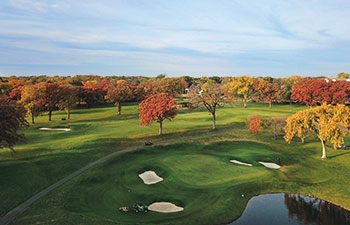
Brandon Schindele, superintendent at Edina (Minn.) Country Club, says his club has experienced a variety of weather extremes in 2018, including a mid-April blizzard, high heat and humidity in the summer and mid-September snow. (Photo: Edina Country Club)
Daniel P. Dingman
President, Michigan Golf Course Superintendents Association
Superintendent, Birmingham Country Club, Birmingham, Mich.
Generally speaking, how was the golf season this year?
From what I have heard around the state, golf rounds were up, and some facilities had record years. While speaking with Kate Moore from the Michigan Golf Association, she agreed and said her board members (golf course owners) all had more “thumbs-ups” than “thumbs-downs.”
How did the weather treat you this season?
The 2018 golf season was extremely challenging for all turf managers across the state of Michigan. The weather was certainly the biggest factor. The season got off to a slow start with late winter snowfall in April and a very wet, short spring season, followed by the arrival of summer in early June. The biggest challenge for me during the summer months was the high nighttime temperatures and the lack of occasional rain showers to reset moisture levels.
How would you describe the disease pressure this year, and what diseases were most prevalent?
Disease pressure was very high for the entire season. Humidity percentages were consistently high, and combined with both day and night temperatures, made every day a challenge. Under these conditions, disease pressure will always be a concern for turf managers. Thankfully, the products available to combat the disease pressure continue to improve each year and help us throughout the season.
What was the biggest challenge your area had to deal with this year?
Along with the weather, the biggest challenge for me and others this year was finding good employees. Each year it becomes more and more difficult to find employees who are willing to get up every morning at 4 a.m. and work a physical job all day. An increase in the starting wage has helped, but the struggle still continues.
Are there any success stories from your chapter that stand out in your mind?
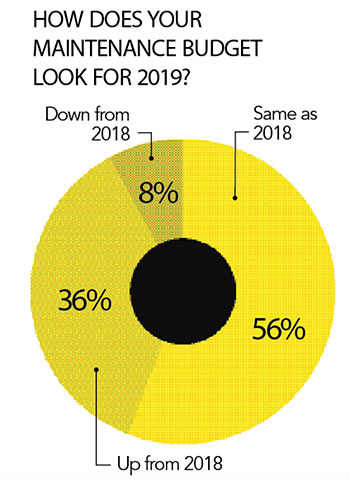
Figure 3 (Graphic: Golfdom Staff)
We started a match play championship event that was open to 32 two-person teams this year, which has really been a hit. The four people playing set the matches on their own timeframe and picked a course they would normally not play. I am looking forward to our conference this winter to see who is chatting with whom, as I think new relationships have been fostered by this season-long statewide event.
We’ve also started hosting some non-superintendent education that targets assistants, equipment managers and crew members — a way for our members to learn a little more about what they are doing and why. I think this may be the wave of the future for our chapter, as our superintendent members’ time and responsibilities have become so tight. We are planning to do more and see where it goes. Overall, it has been another great year, and we could not do it without the support of our valuable industry partners.
— Interviewed by Chris Lewis
Eric O’Neill
President, Long Island Golf Course Superintendents Association
Director of Grounds, North Shore Towers Country Club, Floral Park, N.Y.
Generally speaking, how was the golf season this year?
At my club, golf rounds were down considerably for the season. In fact, we had nearly 1,000 fewer rounds played this year than last — and, this August, we recorded the lowest amount of golf rounds of any other August in the history of our club.
How did the weather treat you this season?
The wet weather was a primary reason golf rounds were down. Also, the wet weather (5 inches in July and 4 inches in August) made it difficult to maintain the course’s condition. Aside from the rain, temperatures were also higher than usual, which also contributed to the decline in golfers’ participation.
How would you describe the disease pressure this year, and what diseases were most prevalent?
The disease pressure — from three primary diseases: root Pythium, brown patch and early fall gray leaf spot — was very high this season. I believe these diseases were highly prevalent for two reasons. First, the humidity levels and nighttime temperatures in Floral Park were higher than normal. The total number of days with dew points above 70 was the highest ever recorded — it was hot and wet. Not to mention, there were also 100 days in which the high temperatures were at least 80 degrees, much more than usual.
What was the biggest challenge your area had to deal with this year?
Staffing has been the biggest challenge for our area the last few years. This season we were definitely understaffed because of the weather. Our primary issue was ensuring we didn’t do more harm than good when we mowed, groomed or rolled wet turf. So, we usually had staff come back to mow during the evenings much more often than we have in the past.
— Interviewed by Chris Lewis
Jimmy Rodriguez
President, New Mexico Golf Course Superintendents Association
Superintendent, Towa Golf Course, Santa Fe, N.M.
Generally speaking, how was the golf season this year?
The golf season in New Mexico, basically last September we didn’t get much moisture from September 30th on. At my course we got about a half-inch of any type of moisture, snow or rain. And that was pretty much the case for the entire state. It was extremely dry. A lot of guys had turf issues. A lot of guys had to re-pressure, like myself. I re-pressured after four weeks blown out and had to try to water what I could safely on the course with frozen ground. You heard that from everyone in the state. They were watering and trying to save turf as much as they could, and it carried over to the early spring and into the summer when moisture was lacking… so guys struggled all year without any type of moisture.
How did the weather treat you this season?
Getting better. We’ve gotten a lot more moisture the last few months, the monsoons were OK, but the last couple years we’ve seen that the monsoonal rains normally will be heavy in July and now they’re shifting into August. The last two months have been pretty good around the state. Everybody seems to be getting more moisture than they were this time last year, which was zero.
How would you describe the disease pressure this year, and what diseases were most prevalent?
Disease pressure in New Mexico is not very great due to the dryness. So, for where we are in Santa Fe and north, most of the courses do snow mold protection. Most of the courses south of us, even 25 miles south, they can water throughout the season… so I don’t know that they do any snow mold protection. Disease pressure isn’t like what they have on the East Coast or in the South — snow mold and that’s it.
What was the biggest challenge your area had to deal with this year?
Going back to the lack of moisture we’re getting and water depletion of reserves in the ground. That’s the biggest thing going forward.
Labor is a continuing problem all over the U.S., and luckily for me I’ve kept the same staff, but generally speaking it’s getting more difficult to find and retain employees. Santa Fe has what they call a living wage base, in that aspect they have a minimum wage that is one of the top three in the nation. That’s hard to compete with. In certain counties they have been adopting this. Guys come to your facility and you’re offering a certain amount and they can go to McDonald’s and make a dollar more, it’s really tough.
— Interviewed by Seth Jones
Craig Cahalane
President, Rocky Mountain Golf Course Superintendents Association
Superintendent, Pole Creek Golf Club, Winter Park, Colo.
Generally speaking, how was the golf season this year?
Personally, it was very good, we did about 25,000 rounds in four months at 8,600 feet. Very good. We started off a little slow, with 13 damaged greens from the winter. We had ice damage, freeze/thaw cycles. Thirteen out of 30 greens were really damaged, but we were 100 percent back by July.
How did the weather treat you this season?
It was extremely dry. Also, at our elevation, we don’t see many days in the 80s, but we had over 30 days in the 80s. It was a hot, dry season. Moisture-wise, we only had 4 inches for the months we irrigate — not much at all.
How would you describe the disease pressure this year, and what diseases were most prevalent?
We don’t see much disease pressure. We get a little anthracnose, but as dry and arid as we are, there’s not much pressure.
What was the biggest challenge your area had to deal with this year?
The weather, the hot/dry. And there were a lot of forest fires — that keeps everyone on edge. We had a forest fire within 10 miles of us, and when we were in Grand Lake for one of our meetings, there was one right next to them. I’m lucky because we can draw (labor) from the ski area. Our issue is housing for our laborers, there isn’t enough housing to go around.
Are there any success stories from your chapter that stand out in your mind?
It’s our conference, we just held the second annual Rocky Mountain GCSA Annual Meeting. The first one was good, a lot of attendees, but in only its second year we are up to 215 attendees. The number of people coming out for it has been great, we’ve had great speakers and I think it’ll keep growing every year.
— Interviewed by Seth Jones
Rob Daniel
President, Carolinas Golf Course Superintendents Association
CGCS, RiverTowne Country Club, Mount Pleasant, S.C.
Generally speaking, how was the golf season this year?
The golf season has been challenging, as always. The year began with the area receiving a blanket of snow that lingered for many days — from Hilton Head up the coast to North Carolina. Many bermudagrass courses suffered winterkill as a result of these cold conditions. Courses inland suffered as well. If courses didn’t use covers for their bermudagrass greens in the past, they’ve probably purchased them this year as a result of the cold winter.
The summer was hot, though, and provided very good weather for recovery — until hurricane season came. Hurricane Florence was a massive blow, and the flooding associated with all the rain was devastating for many areas in South Carolina. Golf courses continue to recover from that storm as we prepare for other storms.
How did the weather treat you this season?
We were very lucky at RiverTowne Country Club. The weather has had no major impact on our operation, as there wasn’t any major turf or course damage from weather-related events. The only closures were due to snow and rain.
How would you describe the disease pressure this year, and what diseases were most prevalent?
Here on bermudagrass, there was not anything to get excited about disease-wise. It was a pretty normal year.
What was the biggest challenge your area had to deal with this year?
The biggest challenge for us here at our course was the snow in January. Many roads were covered with ice and snow for almost a week, leading to a very slow start for the golf season.
Are there any success stories from your chapter that stand out in your mind?
The people within the Carolinas chapter have success stories all of the time — there are just too many to mention. I’d say I’m most proud of how well our members work together to solve problems. Natural disasters, turf-related issues and beyond, our people are the highlight of our association.
— Interviewed by Chris Lewis
Kenny Dierschke
President, West Texas Chapter Golf Course Superintendents Association
Superintendent, Yoakum County Golf Course, Denver City, Texas
Generally speaking, how was the golf season this year?
We had an average golf season this year as far as play is concerned. Our revenue is generally based on how well the oil industry is doing.
How did the weather treat you this season?
We had a very unique growing season this year. We are located in the southern plains of West Texas, so our weather is anything but normal. With winter starting in November 2017 and continuing until June 2018, we only had 0.8 inches of rain. But since that time, we have been blessed with an abundant amount of rainfall, totaling over 17 inches.
How would you describe the disease pressure this year, and what diseases were most prevalent?
Normally, our region is not heavily pressured from disease. However, this year there have been issues associated with the abnormally high humidity and rainfall. I have been on a preventative fungicide program for the last several years, so even though we are not usually under a great amount of disease pressure, scheduled applications have improved the health of our greens.
What was the biggest challenge your area had to deal with this year?
We began this year dealing with sodium buildup on greens due to the dry months of winter and spring. Then we moved on to dealing with something growing in our irrigation lines. I’m not quite sure what it is, but I’ve narrowed it down to something similar to Bryozoa. Whatever it is, it clogs up our sprinkler heads and valves and requires us to flush heads daily, which takes a lot of our time.
Are there any success stories from your chapter that stand out in your mind?
I have been a member of this association for over 25 years. Our superintendents and vendors are all friends. I think I can speak for almost every member about this — I feel as though anyone can call anyone in the association about anything. Over the last several years, we have focused on growing a scholarship and research fund. We also started a golf tournament to raise money for these funds. Thanks to the help of our vendors, it has been very successful.
— Interviewed by Chris Lewis
Brian Smoot
President, Golf Course Superintendents Association of Cape Cod
Superintendent, Crosswinds Golf Club, Plymouth, Mass.
Generally speaking, how was the golf season this year?
We’re typically a busy course, and as the season went on, we had a fair amount of play. The fall has been a little wet.
How did the weather treat you this season?
The strangest weather year in the 13 years I’ve been in the Cape Cod area.
In March and April, the course was blasted with rain. I think we had three or four Nor’easters in a row, that’s how it started. Then it seemed like we went from that to really, really, really hot weather… we had some of the hottest days I’ve ever seen in my life. Then it went to rain event after rain event after rain event in September and October.
How would you describe the disease pressure this year, and what diseases were most prevalent?
With very, very hot nights — low temperatures at night often were 75 degrees — a lot of people had Pythium blight… wet wilt from trying to water in those conditions, being so hot and scorched. But a lot of Pythium pressure.
What was the biggest challenge your area had to deal with this year?
The weather.
Any success stories from your chapter stand out in your mind?
Something that the chapter did… it completed an economic impact study of golf on Cape Cod… it’s been at least two or three years in the making.
— Interviewed by Ed Hiscock
Mark Woodward
Treasurer, Cactus & Pine GCSA
Director of Agronomy, CGCS, Whisper Rock Golf Club, Scottsdale, Ariz.
Generally speaking, how was the golf season this year?
Lately, golf in Arizona has been good. Rounds are up at a lot of golf courses. Revenues are holding their own. The contributions that golf makes in Arizona are tremendous because we’re a destination area.
How did the weather treat you this season?
The weather has been decent up until this fall. We’ve had our wettest October in history. We had 6 inches in the month of October, so we had about our average annual rainfall in one month. In October, it’s usually less than an inch.
How would you describe the disease pressure this year, and what diseases were most prevalent?
We’re pretty dry and don’t have a lot of humidity, so we don’t have too much disease pressure in my area. Some of the courses in northern Arizona deal with snow mold. We might’ve had anthracnose on our greens and minor things like that.
What was the biggest challenge your area had to deal with this year?
Water is our No. 1 issue. The Cactus and Pine partnered with the Department of Agriculture and Resource Economics and the Cooperative Extension Service with the University of Arizona to conduct an economic impact study a couple years ago… it found golf courses only use about 1.9 percent of Arizona’s freshwater withdrawals. Superintendents here are good stewards of the environment.
Any success stories from your chapter stand out in your mind?
We’re working with GCSAA on putting together some best management practices that are specific to Arizona. That’s something we’re really proud of.
— Interviewed by Sarah Webb
Brandon Schindele
President, Minnesota Golf Course Superintendents Association
Superintendent, Edina Country Club, Edina, Minn.
Generally speaking, how was the golf season this year?
Golf season was out of the ordinary, if you can even describe an ordinary season. It’s just been a period of some extremes that we’ve had at some inopportune times.
How did the weather treat you this season?
We had a snowstorm that dropped about a foot and a half of snow around April 20. Then by Memorial Day weekend, we were already up in the ’90s. We’ve had some pretty significant periods of rain… and some heat and humidity that we haven’t experienced for a few years. We had snow on the golf course last weekend (mid-September).
How would you describe the disease pressure this year, and what diseases were most prevalent?
In the state, there was a lot of dollar spot pressure, and for the first time in a while, we saw some brown patch, summer patch and Pythium in the area starting to break through because of the heat, humidity and periodic rain.
What was the biggest challenge your area had to deal with this year?
Staffing is always a big issue, and trying to get people out here in the Twin Cities for our shoulder seasons — spring and fall.
Any success stories from your chapter stand out in your mind?
Our executive director, Jack Mackenzie, was awarded through GCSA an environmental leadership type of award. We got a grant from PBI-Gordon for the number of people we had attend GIS. We’re funding the Great Lakes Turfgrass School — an online 10-week program that starts in January, and we’re going to fund up to five individuals.
— Interviewed by Sarah Webb
Scott Sutton
President, Southern Nevada Golf Course Superintendents Association
Director of Agronomy, The Club at Sunrise, Las Vegas
Generally speaking, how was the golf season this year?
This golf season was pretty good around the whole valley. It was a bit above average. The economy is doing better, and people are spending more money. Our tourism was up.
How did the weather treat you this season?
We had a little bit above-average warm temperatures this summer. In the summertime we’ll get up to 100 and the teens, 115, 116. We’re just a hair over 3 inches (of rain) this year.
How would you describe the disease pressure this year, and what diseases were most prevalent?
Because we don’t have the rain and humidity, we don’t get a whole lot of diseases out here in the desert. We might get a little bit during monsoon season. Some of the guys fight some brown patch in the summertime. A little bit of summer patch.
What was the biggest challenge your area had to deal with this year?
Lack of water and quality of water. Lake Mead, where we pull our water from, is dropping quite a bit every year. By 2021 there’s a chance we might hit another drought emergency if we don’t get some snowfall and rain up in the Rockies.
Any success stories from your chapter stand out in your mind?
The course I’m at is the only all-paspalum golf course in the state of Nevada. You can take poor quality water and get a really quality golf course out of it.
— Interviewed by Sarah Webb
Paul Derry
President, Northwest Ohio Chapter Golf Course Superintendents Association
Superintendent, Catawba Island Club, Port Clinton, Ohio
Generally speaking, how was the golf season this year?
It was a slow start in the spring because it was cool and wet. Later in the season, the golf conditions got much better and most clubs got back up to their average amount of rounds for the year.
The beginning of July was a tough spot for us because of when the 4th of July fell; it was basically a whole week of a 4th of July holiday — and it was finally nice out. We had over 1,000 rounds in 10 days, so wear really beat us up.
How did the weather treat you this season?
he weather was extremely challenging from a maintenance perspective. We saw a lot of extremes. The spring was very cool and very wet, followed by a very hot and dry July — it was the 14th warmest summer on record, something like that. August wasn’t bad. It’s been a pretty average fall for us, other than it seems late, with the leaves hanging on the trees.
How would you describe the disease pressure this year, and what diseases were most prevalent?
September, we got gray leaf spot. This far north it caught a lot of us off guard, a lot of people mistook it for
Pythium, and those treatments weren’t effective. By the time we figured out what it was, we lost some grass. Aside from gray leaf spot, dollar spot was most prevalent. There were a couple periods where it was pretty high, significantly more than usual.
What was the biggest challenge your area had to deal with this year?
Definitely weather. I think everyone is probably in the same boat with labor, that challenge continues to stay at the top. We do try to take opportunities to go to career fairs and try to promote what’s going on in the industry and let high school students know there are jobs available.
Any success stories from your chapter stand out in your mind?
(Laughs) If you didn’t lose a lot of turf and you kept your job, it was a successful year.
— Interviewed by Abby Hart
Michael Mays
President, Golf Course Superintendents Association of Alabama
Superintendent, Cider Ridge Golf Club, Oxford, Ala.
Generally speaking, how was the golf season this year?
It was about normal, maybe a little bit up from where it was in 2010, 2008. We have more (rounds) this year than last year, by a few hundred. Everyone’s on a slight increase with the amount of play, nothing crazy, but at least it’s a plus.
How did the weather treat you this season?
Our area had several snowfall events in the winter, with each dropping 1 to 3 inches of snow. Cold weather hung around a little longer than usual, and we had very little spring and moderate temps. It went from cold to hot in a matter of three weeks. It was a wet early summer, then it turned dry in August and most of September. For me (on bentgrass), I don’t like wet summers, but the bermudagrass guys are loving life.
How would you describe the disease pressure this year, and what diseases were most prevalent?
Disease pressure was high, with the heat and the rain in early summer. I would say anthracnose, as well as some brown patch, were the biggest diseases.
What was the biggest challenge your area had to deal with this year?
From the association perspective, participation. Trying to stimulate participation from new members and getting more participation from tenured members. As far as the golf course in general: labor. Lack of interested people, most people you hire are just here to get a paycheck and don’t take pride in what they do.
Any success stories from your chapter stand out in your mind?
We set a record for the amount we generated for Rounds 4 Research this year, and we’re working with local businesses and businesses like TopGolf to find new ways to bring our industry together.
— Interviewed by Abby Hart










